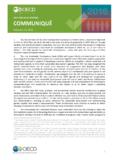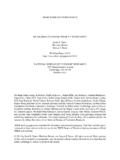Transcription of BIS Working Papers - Bank for International …
1 BIS Working PapersNo 443 Banks and capital requirements: channels of adjustment by Benjamin H Cohen and Michela Scatigna Monetary and Economic Department March 2014 JEL classification: E44, G21, G28. Keywords: banks, bank capital, regulation, capital ratios, Basel III. 4 BIS Working Papers n BIS Working Papers are written by members of the Monetary and Economic Department of the bank for International Settlements, and from time to time by other economists, and are published by the bank .
2 The Papers are on subjects of topical interest and are technical in character. The views expressed in them are those of their authors and not necessarily the views of the BIS. This publication is available on the BIS website ( ). bank for International Settlements 2014. All rights reserved. Brief excerpts may be reproduced or translated provided the source is stated. ISSN 1020-0959 (print) ISSN 1682-7678 (online) ISBN 978-92-9131-144-6 (print) ISBN 978-92-9131-154-5 (online) WP443 Banks and capital requirements: channels of adjustment i Banks and capital requirements: channels of adjustment Benjamin H Cohen and Michela Scatigna1 bank capital ratios have increased steadily since the financial crisis.
3 For a sample of 94 large banks from advanced and emerging economies, retained earnings account for the bulk of their higher risk-weighted capital ratios, with reductions in risk weights playing a lesser role. On average, banks continued to expand their lending, though lending growth was relatively slower among European banks. Lower dividend payouts and (for advanced economy banks) wider lending spreads have contributed to banks ability to use retained earnings to build capital.
4 Banks that came out of the crisis with higher capital ratios and stronger profitability were able to expand lending more. Keywords: banks, bank capital, regulation, capital ratios, Basel III. JEL classification: E44, G21, G28. 1 Special Adviser on International Financial Stability Policy, BIS, and Senior Research Analyst, BIS. An earlier version of this paper appeared in the BIS Quarterly Review as Cohen (2013). The views expressed in this article are those of the authors and do not necessarily reflect those of the BIS.
5 We are grateful to Claudio Borio, Kostas Tsatsaronis and Christian Upper for helpful comments and discussions. WP443 Banks and capital requirements: channels of adjustment iii Contents Introduction .. 1 1. Channels of adjustment .. 1 2. bank capital, lending and growth in the aggregate .. 3 3. Decomposing changes in the risk-weighted capital ratio .. 7 4. Decomposing changes to capital .. 15 5. Assets and lending .. 18 6. A closer look at adjustment strategies .. 21 7. Conclusions .. 24 References.
6 25 Previous volumes in this series .. 27 WP443 Banks and capital requirements: channels of adjustment 1 Introduction In the years since the global financial crisis, both the private and public sectors have exerted pressure on banks to build larger buffers of high-quality capital and reduce the riskiness of their portfolios. This paper examines the broad patterns in how banks have gone about achieving higher risk-weighted capital ratios since the crisis. A key finding is that the bulk of the adjustment has taken place through the accumulation of retained earnings, rather than through sharp adjustments in lending or asset growth.
7 The advanced-economy banks in the sample increased their assets by 8% from 2009 to 2012, while the emerging-economy banks increased assets by 47%. However, European banks have increased their lending more slowly than banks based in other regions. In the advanced economies, a reduction in risk-weighted assets relative to total assets has also played a role, albeit a secondary one. More profitable banks have expanded assets and lending faster than others. There is some evidence for the importance of starting points banks that came out of the crisis with relatively lower levels of capital have been more likely to pursue adjustment strategies involving slow asset growth.
8 The next section reviews the different strategies that banks can use to increase their capital ratios and the differing macroeconomic implications of these strategies if banks pursue them on a large scale. We then look at broad evidence on whether, and in what ways, some of these potential macroeconomic impacts have taken place. The following sections look more closely at the adjustment paths taken by a sample of 94 large global banks. Changes in capital ratios are decomposed into factors reflecting changes in capital and changes in assets, and then each of these is studied in more detail.
9 A concluding section recaps the main findings. 1. Channels of adjustment A bank that seeks to increase its risk-adjusted capital ratio has a number of options at its One set of strategies targets the bank s retained earnings. The bank could seek to reduce the share of its profit it pays out in dividends. Alternatively, it may try to boost profits themselves. The most direct way to do so would be by increasing the spread between the interest rates it charges for loans and those it pays on its funding.
10 Lending spreads would rise across the system if all banks followed a similar strategy and alternative funding channels (such as capital markets) did not offer more attractive rates. Other ways to increase net income include increasing profit margins on other business lines, such as custody or advisory services, or reducing overall operating expenses. Higher bank lending spreads or fees need not be 2 Higher capital requirements were only one element of a range of financial regulatory reforms that have been put in place since the crisis.















